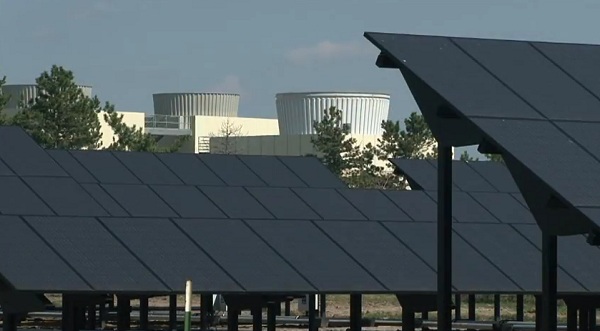A solar array and a strand of DNA might not seem to have much in common. But in April, the University at Buffalo (UB) introduced the Solar Strand, a 3,200-panel solar array that extends in a linear pattern evoking the pattern of a DNA fingerprint. The 750-kilowatt project stands at the main entrance to UB’s north campus, providing a striking gateway to the university.
The university says the Solar Strand, funded by a $7.5 million grant from the New York State Power Authority (NYPA), will provide electricity to hundreds of student apartments, help cut energy costs and reduce UB’s overall carbon footprint. It is expected to produce enough clean, renewable power to help avoid the emission of close to 400 tons of greenhouse gases annually.

The announcement of the Solar Strand immediately followed New York Gov. Andrew M. Cuomo’s April launch of the NY-Sun Initiative, a plan to double the amount of solar power for customers in the state each year and to quadruple that amount by 2013. The comprehensive NY-Sun Initiative expands existing programs administered by the New York State Energy Research and Development Authority (NYSERDA), the Long Island Power Authority, and the NYPA. NYSEDA will provide increased funding for its solar program for larger scale and aggregated systems that currently focuses on businesses, colleges and universities.
The Solar Strand at UB also represents a key element in the NYPA’s Renewable Energy Program to help further commercialization of renewable energy technologies by offering incentives to promote new technologies.
To encourage the growth of the region and state’s clean energy economy, the NYPA board of trustees decided that utilizing local businesses should be a priority in building out the Solar Strand. Nearly 40 New York Buffalo area businesses contributed to the completion of the project, employing hundreds of area residents.
The Solar Strand is just part of UB’s commitment to the environment under its 2020 strategic plan and Building UB: The Comprehensive Physical Plan. The plans fosters the development of facilities to support research and to improve the student experience in all areas, from dining halls and dorms to classrooms and labs.

The project was designed by UC Berkeley professor and landscape architect Walter Hood. Hood has worked in a variety of settings including architecture, urban design, community planning and environmental art and research. He is the 2009-2010 recipient of the Cooper-Hewitt National Design award for landscape design. In August, walkways that weave between the solar panels will open, providing the public a chance to enjoy the site.
And for those outside of Buffalo, you can also experience the Strand, in a way: The university has set up an online solar dashboard that displays the installation’s power generating data. When we checked it yesterday afternoon, under scattered clouds the system was cranking at 549 kilowatts, and had produced nearly 46,000 kilowatt-hours since it was switched on two weeks ago.